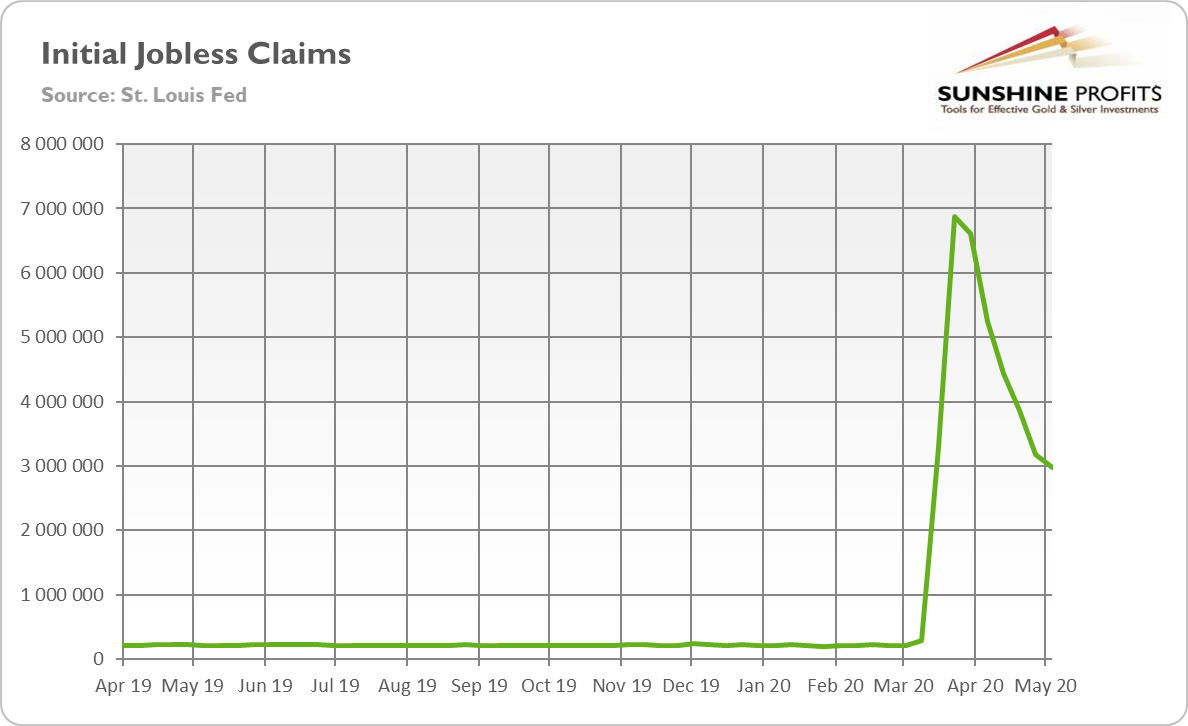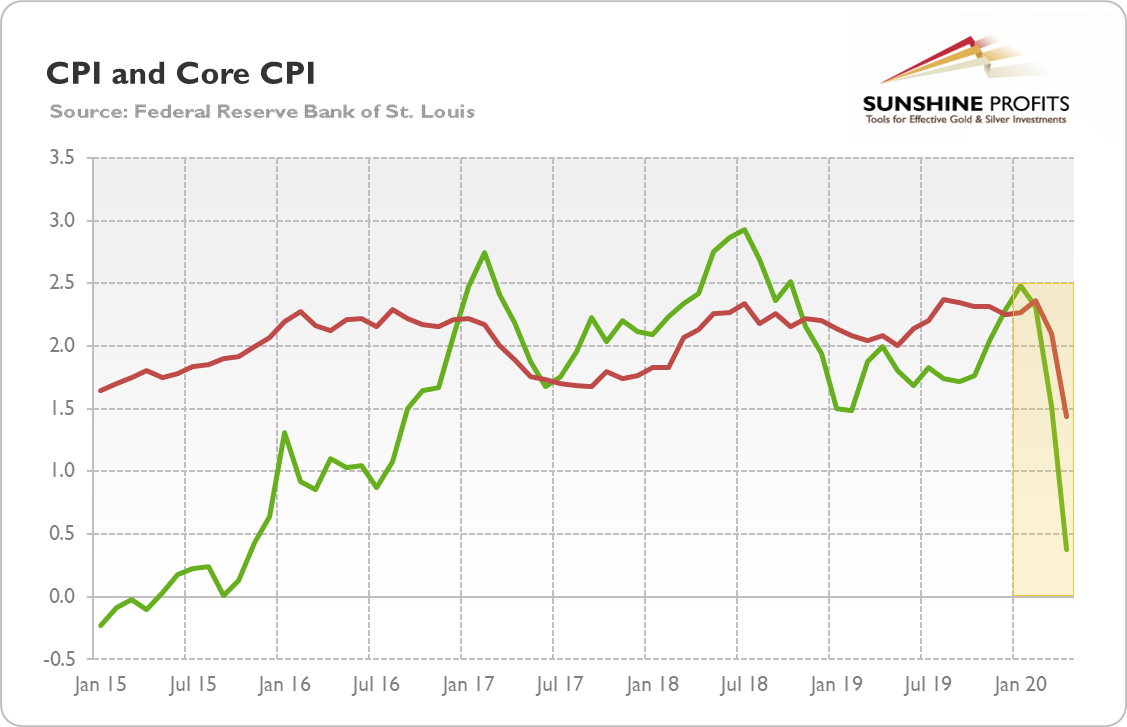There is true havoc in the US labor market, while the inflation rate has declined. What does it mean for the gold market?
True Pandemonium Emerges in the US Labor Market
This week was full of economic data. Let’s analyze them, starting, as usual, from the initial jobless claims, which became one of the most carefully studied indicator during the coronavirus crisis. As the chart below shows, in the week from May 2 to May 9, three million Americans applied for unemployment benefits.
Chart 1: US Initial Jobless Claims from April 6, 2019 to May 9, 2020

It implies two important things. First, the total number of people who applied for the unemployment benefit surpassed 36 million in the United States. It means that the implied naïve unemployment rate (which assumes no dropouts from the labor market) is almost 35 percent. Yes, you read it correctly: about one third of Americans belonging to the labor force is without job. The real unemployment rate is lower, of course, as some people dropped out from the job market, but, on the other hand, lots of states are still underreporting new unemployment claims as they cannot handle the crush of applications. Anyway, the number is probably higher than during the Great Depression!
Second, although the new initial claims are going to subside as states are reopening their economies, the recovery may be slower than commonly believed. Please look at the chart above once again. Although since the end of March, the number of new claims is on the decline, the US economy still loses several million jobs a week. The number of initial claims reached a peak in just two-three weeks, but six weeks have already passed since the peak and is the pre-pandemic level getting closer in sight?
The current havoc in the US labor market is unprecedented. And what is also unprecedented is the behavior of the stock market, given the ongoing pandemonium. One possible reason might be the hope that the crisis is temporary, which is partially justified. However, it might be also the case that the financial markets are a bit complacent, drugged by the Fed’s monetary cocaine. Anyway, gold should get out of crisis strengthened due to the elevated uncertainty, lower real interest rates and higher public debt.
Inflation Rate Drops
And what about inflation? Will we see higher inflation rates? Or lower, as the recent data suggest? The US CPI inflation rate declined 0.8 percent in April, following a 0.4 percent move lower in March. It was the largest monthly decline since December 2008. The decrease was mainly driven by a sharp decline of 20.6 percent in the gasoline prices. However, the core CPI rate, which excludes energy and food prices, also decreased in March – by 0.4 percent (versus 0.1 percent decline in March), as practically all indexes declined, including huge declines in the prices of apparel and transportation services (airline fares posted record drop). The only important exemptions were flat shelter prices, and rising prices of medical care services and food. The drop in the core CPI was the largest monthly decline in the history of the series, which dates to 1957.
On an annual basis, the overall CPI increased 0.3 percent, significantly more than the 1.5 percent rise in March and the 2.3 percent rise in February. It was the smallest 12-month increase since October 2015. The core CPI rose 1.4 percent over the last 12 months, compared to the 2.1 percent increase in the previous month. It was the smallest increase since April 2011. The chart below shows these disinflationary trends.
Chart 2: US CPI (green line) and core CPI inflation rate (red line) from January 2015 to April 2020.

Importantly, gold prices did not show any weakness due to the lower inflation readings. For some people, it might be surprising – but not for our Readers, who know that gold is not just about inflation versus deflation. The yellow metal is a safe-haven asset which may shine during both inflationary and deflationary periods.
Implications for Gold
Does it negate our view that the current crisis could be more inflationary than the Great Recession? Not at all, we actually expected disinflation – we wrote in the Fundamental Gold Report published on April 16 that “in the short term, disinflationary pressure should prevail”. So, we never ruled out the possibility of disinflation or even deflation – the disinflationary pressure was obvious for all economists. What we meant and we still mean is that during the current crisis, there are some forces that were absent during the Great Recession. This is perhaps why the disinflationary pressure has been so far weaker than during the global financial crisis and this is why it could consequently cause relatively higher inflation over the medium and long run.
We mean here the quickly rising the supply of credit and of broad money supply. Additionally, the reopening of economies should strengthen the inflationary pressure compared to the lockdown. It should translate into higher prices eventually, which should support the demand for gold as an inflation hedge. However, investors should remember that the increase in the broad money supply affects the prices with significant lag of several months, and it might be also be the case that the inflationary pressure will affect the asset prices more or earlier than the CPI Index.
Disclaimer: Please note that the aim of the above analysis is to discuss the likely long-term impact of the featured phenomenon on the price of gold and this analysis does not indicate (nor does it aim to do so) whether gold is likely to move higher or lower in the short- or medium term. In order to determine the latter, many additional factors need to be considered (i.e. sentiment, chart patterns, cycles, indicators, ratios, self-similar patterns and more) and we are taking them into account (and discussing the short- and medium-term outlook) in our Trading Alerts.
